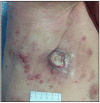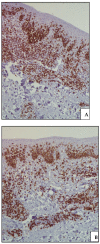Cutaneous Localization of Classic Hodgkin Lymphoma Associated with Mycosis Fungoides: Report of a Rare Event and Review of the Literature
- PMID: 34685440
- PMCID: PMC8537882
- DOI: 10.3390/life11101069
Cutaneous Localization of Classic Hodgkin Lymphoma Associated with Mycosis Fungoides: Report of a Rare Event and Review of the Literature
Abstract
Mycosis fungoides and nodal classic Hodgkin lymphoma (cHL) have been reported to occur concurrently or sequentially in the same patient. A long-lasting mycosis fungoides more often precedes the onset of nodal cHL, although few cases of nodal cHL followed by mycosis fungoides have been observed. Skin involvement is a rare manifestation of cHL that may be observed in the setting of advanced disease. The decrease in skin involvement in cHL is mainly due to the improved therapeutic strategies. The concurrent presence of mycosis fungoides and cutaneous localization of classic Hodgkin lymphoma represents a very uncommon event, with only two cases reported so far. Herein, we describe the case of a 71-year-old man, with a history of recurrent nodal cHL, who developed MF and, subsequently, the cutaneous localization of cHL. The clinicopathological features of the two diseases are described focusing on the main differential diagnoses to be taken into consideration, and a review of the literature is performed.
Keywords: classic Hodgkin lymphoma; mycosis fungoides; skin.
Conflict of interest statement
The authors declare no conflict of interest.
Figures






References
-
- WHO Classification of Tumours Editorial Board, editor. WHO Classification of Tumours Haematopoietic and Lymphoid Tissues. Revised 4th ed. IARC; Lyon, France: 2017.
-
- Parente P., Zanelli M., Zizzo M., Carosi I., Di Candia L., Sperandeo M., Lacedonia D., Fesce V.F., Ascani S., Graziano P. Primary pulmonary Hodgkin lymphoma presenting as multiple cystic lung lesions: Diagnostic usefulness of cell block. Cytopathology. 2020;31:236–239. doi: 10.1111/cyt.12814. - DOI - PubMed
Publication types
LinkOut - more resources
Full Text Sources

